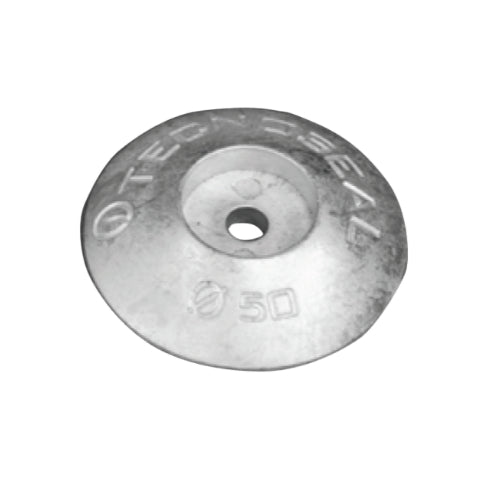Tecnoseal
Rudder Disc technoseal Anode - 50mm
Rudder Disc technoseal Anode - 50mm
Couldn't load pickup availability
Rudder Disc technoseal Anode - 50mm
Anode suitable for use on Trim Tabs or Rudders.
Diameter: 50 mm
Rudder disc anodes are commonly used on marine vessels, especially in areas where protection is needed for the rudder and surrounding components. These anodes are designed to offer sacrificial protection, preventing corrosion from galvanic or electrolysis reactions. Below is a breakdown of where rudder disc anodes are typically used, and also how they relate to swim platforms:
Where Are Rudder Disc Anodes Used?
-
Rudder Protection:
- Primary Application: Rudder disc anodes are specifically designed for the rudder. The rudder is a metal component that is submerged in water and connected to the boat’s steering mechanism. Since the rudder is a critical part of a boat's maneuverability, protecting it from corrosion is vital. The disc anode is often mounted directly on the rudder post or at the base of the rudder, where it provides sacrificial protection to prevent corrosion.
-
Propeller Shaft Areas:
- Secondary Use: Rudder disc anodes are sometimes used in propeller shaft areas or stern tubes to help protect the metal surfaces exposed to saltwater. While their primary function is to protect the rudder, in some cases, they may also be installed in places where corrosion can affect the surrounding systems, such as the shaft or stern gear.
-
Underwater Appendages:
- Rudder disc anodes are also used in areas where other underwater appendages—like the strut, propeller shaft, or other critical metal components—are in danger of corrosion. They are strategically placed in locations with high exposure to saltwater or electrolysis, offering protection to both the rudder and the areas nearby.
How Do Rudder Disc Anodes Work?
-
Galvanic Protection: When installed, rudder disc anodes function as sacrificial anodes, meaning the material of the anode (usually zinc, aluminum, or magnesium) is more reactive (less noble) than the metals used in the rudder or nearby components (e.g., stainless steel or bronze). The anode will corrode in place of the more valuable metal, effectively protecting the rudder and preventing costly damage due to corrosion.
-
Positioning: The rudder disc anode is typically installed where the rudder post meets the waterline, but it can also be used to protect parts of the rudder itself or nearby components. The disc shape allows for effective and even corrosion protection, offering better surface contact and protection compared to other forms of anodes in certain spaces.
Rudder Disc Anodes on Swim Platforms:
While rudder disc anodes are mainly used on rudders, swim platforms can sometimes benefit from anodes as well, particularly if the platform is made of metal and submerged in water. However, swim platforms do not typically use rudder disc anodes directly. Instead, the following applies:
-
Swim Platform Protection:
- If your swim platform is made of metal, such as aluminum, stainless steel, or other alloys, it is susceptible to galvanic corrosion when exposed to water, especially in saltwater environments. In such cases, you may want to use sacrificial anodes like zinc anodes or aluminum anodes attached to the platform or the underwater parts of the boat near the swim platform.
-
Install Anodes on Nearby Underwater Components:
- If the swim platform is not directly exposed to water (in the case of platforms that are partly above the waterline), anodes may be more commonly installed on parts like the transom, stern gear, or propeller shafts. These anodes protect the boat’s submerged metal components, including the swim platform if it is connected to them, from corrosion caused by galvanic action.
-
Use of Disc Anodes Near Swim Platforms:
- If there is a need for more localized protection near the swim platform, you could use disc anodes near metal supports or attachments that connect the platform to the boat’s hull or underwater components. While the rudder disc anode itself is specialized for the rudder, other types of disc-shaped anodes may work similarly in protecting these submerged metal parts near the swim platform.
Where to Place the Anodes for Swim Platform Protection:
- Transom or Stern: If your boat has a swim platform attached near the stern, it's common to install zinc anodes or aluminum anodes along the transom or adjacent to the platform to prevent corrosion in those areas.
- Support Structure: If the swim platform is mounted with a metal frame or has any submerged metal components, an anode can be attached to those areas to protect them from galvanic corrosion.
- Underwater Gear: If your platform has other components like a motor mount, rudder, or propeller shaft nearby, the protection for those parts with sacrificial anodes will help protect the swim platform indirectly.
Conclusion:
-
Rudder disc anodes are primarily used on rudders and other underwater appendages that require protection from corrosion, particularly on boats. Their design makes them efficient at protecting submerged metal surfaces like the rudder post, propeller shaft, and stern gear.
-
Swim platforms can also benefit from corrosion protection, but they typically use different types of anodes (e.g., zinc or aluminum anodes) that can be placed on the transom or metal components attached to the platform. If necessary, disc-shaped anodes may be used near the swim platform to protect metal areas exposed to the water.
By using the appropriate sacrificial anodes, you can ensure your boat’s rudder, swim platform, and other submerged parts stay corrosion-free and last longer.
Share


